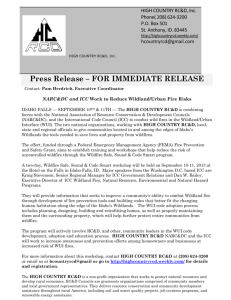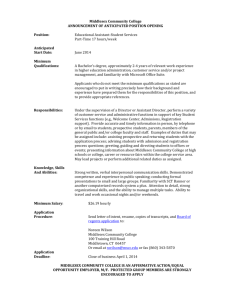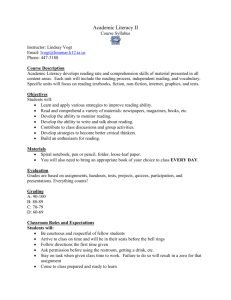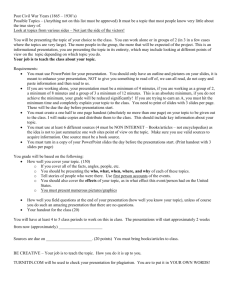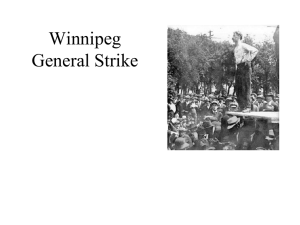Wildland interface strike teams
advertisement
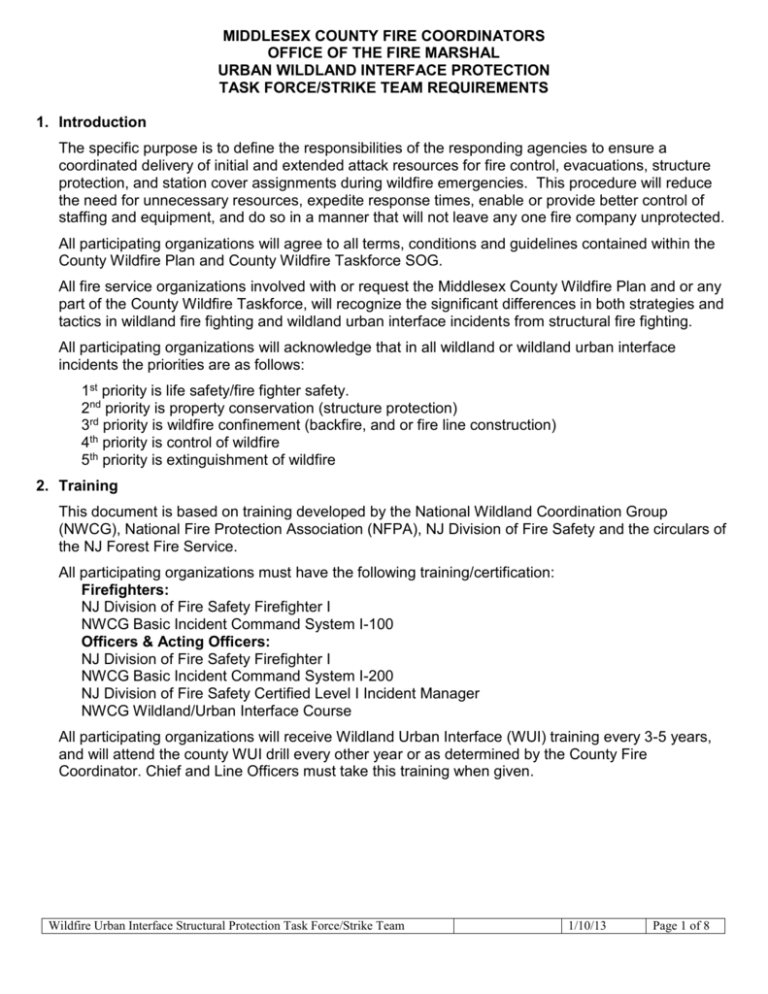
MIDDLESEX COUNTY FIRE COORDINATORS OFFICE OF THE FIRE MARSHAL URBAN WILDLAND INTERFACE PROTECTION TASK FORCE/STRIKE TEAM REQUIREMENTS 1. Introduction The specific purpose is to define the responsibilities of the responding agencies to ensure a coordinated delivery of initial and extended attack resources for fire control, evacuations, structure protection, and station cover assignments during wildfire emergencies. This procedure will reduce the need for unnecessary resources, expedite response times, enable or provide better control of staffing and equipment, and do so in a manner that will not leave any one fire company unprotected. All participating organizations will agree to all terms, conditions and guidelines contained within the County Wildfire Plan and County Wildfire Taskforce SOG. All fire service organizations involved with or request the Middlesex County Wildfire Plan and or any part of the County Wildfire Taskforce, will recognize the significant differences in both strategies and tactics in wildland fire fighting and wildland urban interface incidents from structural fire fighting. All participating organizations will acknowledge that in all wildland or wildland urban interface incidents the priorities are as follows: 1st priority is life safety/fire fighter safety. 2nd priority is property conservation (structure protection) 3rd priority is wildfire confinement (backfire, and or fire line construction) 4th priority is control of wildfire 5th priority is extinguishment of wildfire 2. Training This document is based on training developed by the National Wildland Coordination Group (NWCG), National Fire Protection Association (NFPA), NJ Division of Fire Safety and the circulars of the NJ Forest Fire Service. All participating organizations must have the following training/certification: Firefighters: NJ Division of Fire Safety Firefighter I NWCG Basic Incident Command System I-100 Officers & Acting Officers: NJ Division of Fire Safety Firefighter I NWCG Basic Incident Command System I-200 NJ Division of Fire Safety Certified Level I Incident Manager NWCG Wildland/Urban Interface Course All participating organizations will receive Wildland Urban Interface (WUI) training every 3-5 years, and will attend the county WUI drill every other year or as determined by the County Fire Coordinator. Chief and Line Officers must take this training when given. Wildfire Urban Interface Structural Protection Task Force/Strike Team 1/10/13 Page 1 of 8 MIDDLESEX COUNTY FIRE COORDINATORS OFFICE OF THE FIRE MARSHAL URBAN WILDLAND INTERFACE PROTECTION TASK FORCE/STRIKE TEAM REQUIREMENTS 3. Apparatus Each Structural Protection Task Force shall consist of 6 structural engines and a tender. An engine may be substituted for a tender if unavailable. No more than seven single resources will be included in a Task Force. The sixth engine will be staged as a rapid intervention team or to be staged for deployment in one of the following roles: - Replace an engine company that is rendered out of service during response or operations. Rescue of an engine company. Preparation Unit if equipped with Class A foam eduction or CAFS systems. Supplement an engine company if the holding of a structure (s) is marginal. Each engine will meet the following requirements: Required Equipment - Fully Enclosed Cab & Crew Areas - Hose bed cover - Apparatus number on hood or roof - Minimum Pump Capacity 1000 GPM - Minimum Tank Capacity 750 gallons. Units with less than 750 gallon capacities will be considered if CAFS capable or at the discretion of the Forest Fire Service and or the Middlesex County Fire Coordinators. - Minimum 600' 1.75" hose with 1.5 inch NST threads - Minimum 24 foot ground ladder - Laminated firefighter's guide to Urban /Wildland Situations (Provided by NJFFS) - Common radio frequency between units & Middlesex County Fire Coordinators tx458.575, rx453.575 pl 107.2 - Current county road map (Less than 2 years old) – Hagstrom’s Monmouth/Ocean/Middlesex Edition suggested - 5 gallons of drinking water, Gatorade, or sport drinks First aid kit Middlesex County Fire Coordinators Check In Sheets Recommended Equipment - Apparatus equipped with a personal fire shelter for each crew member - Tank Capacity of 1000 gallons - Hard Suction - Compass or GPS unit - Binoculars Each Tender will meet the following requirements: Required Equipment - Fully enclosed cab - Apparatus number on hood or roof - Jet Siphons and Low Level Strainer - Minimum tank capacity 2000 gallons - Laminated firefighter's guide to Urban /Wildland Situations (Provided by NJFFS) - Common radio frequency between units & Middlesex County Fire Coordinators tx458.575, rx453.575 pl 107.2 Current county road map (Less than 2 years old) – Hagstrom’s Monmouth/Ocean/Middlesex Edition suggested - 5 gallons of drinking water, Gatorade, or sport drinks First Aid Kit Middlesex County Fire Coordinators Check In Sheets Wildfire Urban Interface Structural Protection Task Force/Strike Team 1/10/13 Page 2 of 8 MIDDLESEX COUNTY FIRE COORDINATORS OFFICE OF THE FIRE MARSHAL URBAN WILDLAND INTERFACE PROTECTION TASK FORCE/STRIKE TEAM REQUIREMENTS Recommended Equipment - Apparatus equipped with a personal fire shelter for each crew member - Compass or GPS unit - Binoculars Each Brush Truck will meet the following requirements: Required Equipment - Brush cage - Winch or tow straps/chains with come along - Minimum of 150 gallon water tank - 1 ½ inch hose with ability to pump to 1 ½ inch hose - Basic wildfire tools – Shovel, rake, handsaw, brush broom - ABC fire extinguisher - Apparatus number on hood or roof - Apparatus must be equipped with a personal fire shelter for each crew member - Seating for each member of the crew (don’t overload truck) - Laminated firefighter's guide to Urban /Wildland Situations (Provided by NJFFS) - Common radio frequency between units & Middlesex County Fire Coordinators tx458.575, rx453.575 pl 107.2 - Current county road map (Less than 2 years old) – Hagstrom’s Monmouth/Ocean/Middlesex Edition suggested - 5 gallons of drinking water, Gatorade, or sport drinks First Aid Kit Middlesex County Fire Coordinators Check In Sheets Recommended Equipment - Gas powered chain saw - Compass or GPS unit - Binoculars Each Field Truck will meet the following requirements: Required Equipment - Minimum of 150 gallon water tank - 1 ½ inch hose with ability to pump to 1 ½ inch hose - Basic wildfire tools – Shovel, rake, handsaw, brush broom - ABC fire extinguisher - Apparatus number on hood or roof - Apparatus must be equipped with a personal fire shelter for each crew member - Seating for each member of the crew (don’t overload truck) - Laminated firefighter's guide to Urban /Wildland Situations (Provided by NJFFS) - Common radio frequency between units & Middlesex County Fire Coordinators tx458.575, rx453.575 pl 107.2 - Current county road map (Less than 2 years old) – Hagstrom’s Monmouth/Ocean/Middlesex Edition suggested - 5 gallons of drinking water, Gatorade, or sport drinks First Aid Kit Middlesex County Fire Coordinators Check In Sheets Recommended Equipment - Compass or GPS unit - Binoculars Wildfire Urban Interface Structural Protection Task Force/Strike Team 1/10/13 Page 3 of 8 MIDDLESEX COUNTY FIRE COORDINATORS OFFICE OF THE FIRE MARSHAL URBAN WILDLAND INTERFACE PROTECTION TASK FORCE/STRIKE TEAM REQUIREMENTS 4. Personal Protective Equipment: Required Equipment Each firefighter will be equipped with and have ready for immediate deployment, the following: - Structural Turnout Pants & Coat - Flame Resistant Hood - Structural FF Helmet - Structural FF Gloves - Structural FF Boots - Open Circuit Positive Pressure SCBA (30 minute bottle minimum) *Structural Protection Taskforce only* - NFPA and ANSI Approved Safety Goggles - A minimum of 2 cell Handlight - 1 Portable Radio per two FF team Recommended Equipment - Brush truck and field truck units are recommended to utilize wildfire protective clothing. 5. Organization The New Jersey Forest Fire Service will have responsibility of all fire suppression and protection of lives and property during wildfire and WUI incidents. The NJFFS will use a unified command whenever possible, however the NJFFS will reserve the right to keep a singular command structure when warranted. During a unified command structure, the local Fire Chief or County Fire Coordinator will be the Structural Protection Branch Director until the NJFFS Incident Management Team arrives. The local Fire Chief or County Fire Coordinator must have been trained in WUI to hold that position. The NJFFS Incident Management Team will be dispatched to all WUI incidents and to Wildfires when required by NJFFS Circulars. For WUI incidents the NJFFS IMT will have Structural Protection Specialists that will assume the structural protection branch director and or other positions as directed by the IC. Pre Planned Taskforces/Strike Teams - Each Task Force/Strike Team will be organized into a maximum of 5-7single resources assigned to a Leader from one of the units. The Leader will be chosen by the county fire coordinators, NJ State Forest Fire Service or staging officer. The Leader will report into the Operations Chief or Incident Commander as appropriate. - Each Task Force/Strike Team will be organized into groups based on geographic region, common radio frequency, and work history. Field Organized - The Wildland or WUI incident will be divided into divisions and or branches at the direction of the IC. Division Supervisors will be assigned to each division, these will normally be a Forest Fire Warden of the NJFFS, and if no Forest Fire Warden from the NJFFS is available a municipal fire dept line officer, and or County Fire Coordinator that has received the WUI training will be assigned as the Division Supervisor. Wildfire Urban Interface Structural Protection Task Force/Strike Team 1/10/13 Page 4 of 8 MIDDLESEX COUNTY FIRE COORDINATORS OFFICE OF THE FIRE MARSHAL URBAN WILDLAND INTERFACE PROTECTION TASK FORCE/STRIKE TEAM REQUIREMENTS - When possible, all units on any Taskforces or Strike Teams will muster at a nearby staging area, in which all units will be checked in, and receive a briefing. Each apparatus/unit should have a county check-in sheet on their apparatus, and have it completed before reaching the staging area(s). Apparatus may stay in pre-arranged Taskforces or Strike Teams or placed into an incident formed Taskforce or Strike Team. Each Taskforce or Strike Team will only leave the staging area(s) when directed by a County Fire Coordinator or Staging Area Manager assigned by the County Fire Coordinator. - Requests for resources from the staging area will ONLY come from a County Fire Coordinator with approval from the Operations Section Chief or IC. - Division Supervisors will have a radio frequency assigned in which all Taskforces, Strike Teams, and any other units in the Division Supervisors division will be able to communicate to him or her. (Intra Division Coms) Also, an additional frequency will be available for the Division Supervisor to contact the Branch Director, Operations Section Chief, and the ICP. (Command Coms) - All Taskforces, Strike Teams, and any other units will keep a unit log and submit the log to checkout and the end of the incident. - The company officer on the first engine of any of the Taskforces or Strike Teams will act as the Taskforce or Strike Team leader. The Taskforce or Strike Team leader will be the only point of contact from the Taskforce or Strike Team to the Division Supervisor, Branch Director, Operations Section Chief or ICP. (except for MAYDAYS or other EMERGENCY Information) - The IC will be responsible for all command and general staff functions, until he or she designates such functions, or until an IMT arrives. - The Plans Section Chief will begin planning needs ASAP, and will activate all units as needed. - The Resource Unit will keep tract of and provide reports of all agencies, fire departments, and other resource used on Wildfire or WUI incidents. - The Situation Unit will keep tract of the Wildfire or WUI incident at all times, and will provide reports as directed by the Plans Section Chief or IC. - The County Fire Coordinator representative at the ICP will be the contact for all requests for municipal, and county agencies. A County OEM representative may be needed as a Liaison Officer within the command structure. 6. Activation Upon arrival and size up of a Wildland Fire Incident (Brush Fire) that will require the protection of structures beyond the resources of the local fire mutual aid plan. The Incident Commander or New Jersey State Forest Fire Service will immediately request the following from local dispatch: - Notification of NJ State Forest Fire Division B - Notification of a Middlesex County Fire Coordinator requesting the following: -Mobilization of Structural Protection Task Force/Strike Team(s) The IC should state the site of deployment, assignment priorities, a local contact and operating frequency. Wildfire Urban Interface Structural Protection Task Force/Strike Team 1/10/13 Page 5 of 8 MIDDLESEX COUNTY FIRE COORDINATORS OFFICE OF THE FIRE MARSHAL URBAN WILDLAND INTERFACE PROTECTION TASK FORCE/STRIKE TEAM REQUIREMENTS Upon activation, the County Fire Coordinator will: - Refer to Attachment B- Wildland Urban Interface Structural Protection Task Force/Strike Teams. - Select a Task Force/Strike Team (s) that is geographically closest but not currently employed at the scene. Upon arrival assess resources, reorganize if necessary and request supplemental resources. - Dispatch all Middlesex County tenders (attachment A) and assign them to the staging area for deployment. - Begin calling the dispatch organizations and requesting listed units. Relaying site of deployment/staging, assignment priorities, and a local contact and operating frequency. This may be delegated to the second fire coordinator but must be a done immediately. - Upon completion of dispatch report to Incident Commander. - In cooperation with Incident Commander, regularly evaluate the need for more resources and relief efforts. - Activate Task Force/Strike Teams, Strike Teams and single resources as required. - Replacement of a Structural Protection Task Force/Strike Team may be only achieved with another Structural Protection Task Force/Strike Team. The Middlesex County Hazmat Unit will be notified of any large or possible developing Wildfires or WUI. Any possible hazmat or undetermined containers debris, or other signs of possible hazmat, will require a response of the Middlesex County Hazmat Unit. Any fires on or near the several Super Fund Sites or any other hazardous areas, the Middlesex County Hazmat Unit will be requested. Local fire departments will activate the county wildfire plan, after a second alarm is reached for a Wildfire or WUI incident. Any County Fire Coordinator, State Forest Fire Warden, or Fire Chief can activate this plan whenever necessary. When a Wildfire or WUI has potential to escalate to a complex or expanding incident that may require additional resources, this plan will be enacted. 7. Response When an engine arrives to provide structure protection they will stretch at least one 1 ¾ hose line, multiple family dwelling or commercial structures may require several engines and hose lines. Structural Engines (type 1 engine) or Wildland engines maybe asked to perform patrol or mop-up operations. - Patrol- is to travel a specific stretch of road or area to ensure no fire has jumped fire control lines or roads. - Mop-up- is to work an area to ensure all fire, hot spots, spot fires are extinguished. The Operations Section Chief will specify how far in from the control line to mop up. (ex. mop-up 25 feet from the control lines) Wildfire Urban Interface Structural Protection Task Force/Strike Team 1/10/13 Page 6 of 8 MIDDLESEX COUNTY FIRE COORDINATORS OFFICE OF THE FIRE MARSHAL URBAN WILDLAND INTERFACE PROTECTION TASK FORCE/STRIKE TEAM REQUIREMENTS Engines companies will not hook up to hydrants, nor will they lay any supply lines. Engine companies will not attempt to extinguish the wildfire. A water tender will be assigned to each Taskforce for a mobile water supply. Engine companies shall not put out the wildfire. They shall conserve and save water to keep structures from burning. The engine companies MUST STAY MOBILE. - 1st This is a major firefighter safety issue. - 2nd Engines will most likely be needed to quickly relocate to protect additional structures. It is within the policies of the NJ Forest Fire Service to burn out areas of a Wildfire, and or use backfires when necessary. Only the lead Forest Fire Service Warden can authorize and conduct any burn out or backfire operations. Once a fire front passes a structure(s) the Taskforces or Strike Teams will most likely be required to relocate to a new location to protect additional structures. Once additional Taskforces or Strike Teams arrive, they can be assigned to recheck areas that were left after the fire front had passed, or used for either additional mop-up or relief. All Taskforces, Strike Teams, and any other units will need rehab, and should be sent to the rehab area(s) for rehab. The Staging Area Manager will keep track of all units coming in and out of staging, as well as when units have finished their rehab and placed back into service. Once the Taskforces, Strike Teams, and any other units have completed their assignments and their supervisor approved their reassignments, the Taskforces, Strike Teams, and any other units shall return to the rehab or staging area(s) for rehab or reassignment. 8. Conclusion An After Action Review will take place with representatives from all responding agencies involved, within two weeks or as soon as possible. Nothing in this procedure is to preclude the local Incident Commander or New Jersey State Forest Fire Service from taking necessary actions and steps to aquire resources for the protection of life and property in the absence of a County Fire Coordinator or NJ State Forest Fire Service. This plan can be altered or changed by the County Fire Coordinators or NJ State Forest Fire Service to meet the needs of the incident. Wildfire Urban Interface Structural Protection Task Force/Strike Team 1/10/13 Page 7 of 8 Wildfire Urban Interface Structural Protection Task Force/Strike Team 1/10/13 Page 8 of 8

